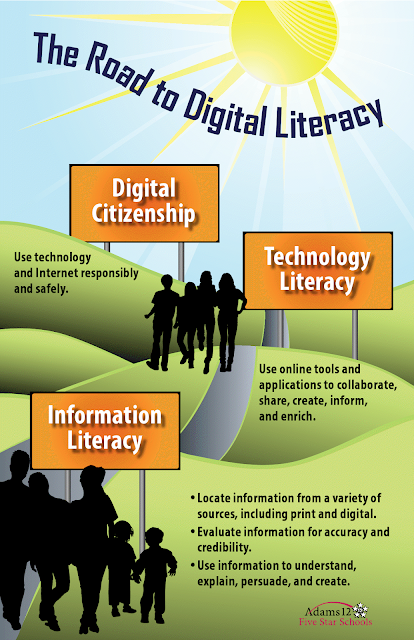Considerations for Purchasing Technology
As one of the Instructional Technology Coordinators for Adams 12 Five Star Schools, I am frequently called upon by principals to assist with technology purchasing decisions. Often it seems that people are hoping to hear of one tool that is the "magic bullet" for all tech integration purposes, but alas, no such device exists. My goal during these meetings is to help buildings determine not only what technology to purchase but also help focus their instructional purpose for the technology. As a result of these meetings, I've found that there are common themes and considerations that surface each time.
To help with the process and to highlight these themes, I recently wrote an article for the Adams12 Learning Services Newsletter, which you can read below:
If you are considering purchasing new technology for a classroom or your school, many factors must be considered to ensure that the devices you select will best meet your needs. Although price is an obvious factor, purpose, device type, “hidden expenses”, existing software/resources, and management should all be investigated.
Above all, how teachers and students will use the devices is key. With blended learning and online resources such as databases, Web 2.0 tools, and eBooks, technology can be used to enhance instruction and allow for differentiation, collaboration and creativity now more than ever. Gone are the days of simply taking students to a computer lab to word process or practice multiplication facts. Research now clearly indicates that in order to maximize learning, devices should be available in classrooms for students to use at any time as needed (i.e. just-in-time learning). Even a handful of devices in each classroom is preferable to the computer lab setup, as it has been proven time and again that scheduling conflicts, testing windows, and lack of regular practice with technology are insurmountable obstacles to effective tech integration.
The device you select will dictate what additional expenses may be necessary. If purpose does dictate that devices be deployed in classrooms rather than in a lab setting, then mobile devices will be preferable to desktop computers. Mobile devices not only take less space in the classroom and eliminate the need for dedicated furniture, but also allow for flexible grouping as mobile devices can be interspersed throughout the classroom. Teachers can also easily borrow devices from one another to improve the student per device ratio if necessary.
However, mobile devices require their own unique set of expenses. Although you won’t need to purchase furniture and install additional Internet drops and/or power outlets in each classroom, you will need to have your IT System Administrator survey your building to determine if there is adequate wireless coverage to support additional devices. You may also want to consider purchasing a charging cart or tray to streamline charging and updates for your chosen devices, though this may or may not be necessary depending on which devices you choose and how many.
Additionally, you need to ensure that all instructional tools will run on the devices you choose, therefore it is important to consider any previous investments in software, online databases, and curriculum subscriptions. Although many software programs now have comparable or even superior free app or Web 2.0 tool counterparts, some database may not run on certain devices due to Flash or Java limitations. Additionally, many schools are considering investing in Apple or Android tablets, which allow you to run apps. Be sure to investigate which apps are available in the respective marketplaces, their cost, and whether they will address your standards and be age appropriate. When exploring devices, it is critical to determine whether the tools you need will run or be available on the device you purchase.
Finally, it is critical to consider how the new devices will be managed. For example, if you choose to purchase tablets, how will app installation be managed? It can take hours upon hours to manually configure each tablet with the proper settings and apps. Even after the initial setup, simply adding or removing a few apps from each device can take hours. Therefore, you will want to ensure that you choose a device that will be easy to manage or invest in the management tools that will take the hassle out of these procedures. Like wireless infrastructure and charging carts, manpower is a “hidden expense” that is often overlooked. If teachers/staff are spending hours managing mobile devices, this is time not spent on planning, grading, instruction, etc.
Choosing the right device for your school or building can be a daunting task! The perfect device for one teacher or school may not be right for you. Be sure to involve building technology coordinators, system administrators and others in your district involved with instructional technology before finalizing purchasing decisions. Including these key players can help streamline the process and help you avoid investing in devices that may not meet your needs.
To help with the process and to highlight these themes, I recently wrote an article for the Adams12 Learning Services Newsletter, which you can read below:
If you are considering purchasing new technology for a classroom or your school, many factors must be considered to ensure that the devices you select will best meet your needs. Although price is an obvious factor, purpose, device type, “hidden expenses”, existing software/resources, and management should all be investigated.
Above all, how teachers and students will use the devices is key. With blended learning and online resources such as databases, Web 2.0 tools, and eBooks, technology can be used to enhance instruction and allow for differentiation, collaboration and creativity now more than ever. Gone are the days of simply taking students to a computer lab to word process or practice multiplication facts. Research now clearly indicates that in order to maximize learning, devices should be available in classrooms for students to use at any time as needed (i.e. just-in-time learning). Even a handful of devices in each classroom is preferable to the computer lab setup, as it has been proven time and again that scheduling conflicts, testing windows, and lack of regular practice with technology are insurmountable obstacles to effective tech integration.
The device you select will dictate what additional expenses may be necessary. If purpose does dictate that devices be deployed in classrooms rather than in a lab setting, then mobile devices will be preferable to desktop computers. Mobile devices not only take less space in the classroom and eliminate the need for dedicated furniture, but also allow for flexible grouping as mobile devices can be interspersed throughout the classroom. Teachers can also easily borrow devices from one another to improve the student per device ratio if necessary.
However, mobile devices require their own unique set of expenses. Although you won’t need to purchase furniture and install additional Internet drops and/or power outlets in each classroom, you will need to have your IT System Administrator survey your building to determine if there is adequate wireless coverage to support additional devices. You may also want to consider purchasing a charging cart or tray to streamline charging and updates for your chosen devices, though this may or may not be necessary depending on which devices you choose and how many.
Additionally, you need to ensure that all instructional tools will run on the devices you choose, therefore it is important to consider any previous investments in software, online databases, and curriculum subscriptions. Although many software programs now have comparable or even superior free app or Web 2.0 tool counterparts, some database may not run on certain devices due to Flash or Java limitations. Additionally, many schools are considering investing in Apple or Android tablets, which allow you to run apps. Be sure to investigate which apps are available in the respective marketplaces, their cost, and whether they will address your standards and be age appropriate. When exploring devices, it is critical to determine whether the tools you need will run or be available on the device you purchase.
Finally, it is critical to consider how the new devices will be managed. For example, if you choose to purchase tablets, how will app installation be managed? It can take hours upon hours to manually configure each tablet with the proper settings and apps. Even after the initial setup, simply adding or removing a few apps from each device can take hours. Therefore, you will want to ensure that you choose a device that will be easy to manage or invest in the management tools that will take the hassle out of these procedures. Like wireless infrastructure and charging carts, manpower is a “hidden expense” that is often overlooked. If teachers/staff are spending hours managing mobile devices, this is time not spent on planning, grading, instruction, etc.
Choosing the right device for your school or building can be a daunting task! The perfect device for one teacher or school may not be right for you. Be sure to involve building technology coordinators, system administrators and others in your district involved with instructional technology before finalizing purchasing decisions. Including these key players can help streamline the process and help you avoid investing in devices that may not meet your needs.


Comments
Post a Comment